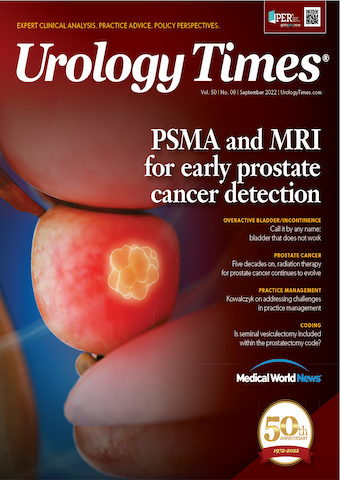Publication
Article
Urology Times Journal
FDA grants priority review to olaparib/abiraterone combo for mCRPC
Author(s):
The FDA has granted a priority review to a supplemental New Drug Application (sNDA) for olaparib (Lynparza) for use in combination with abiraterone acetate (Zytiga) and prednisone or prednisolone for the treatment of adult patients with metastatic castration-resistant prostate cancer (mCRPC).1
The sNDA is supported by the phase 3 PROpel trial, which showed that adding olaparib (Lynparza) to frontline abiraterone acetate (Zytiga) and prednisone/prednisolone significantly improved radiographic progression-free survival (rPFS) in patients with mCRPC.
The findings, which were presented at the 2022 ASCO Genitourinary Cancers Symposium andpublished in the New England Journal of Medicine Evidence, showed that the median investigator-assessed rPFS was 24.8 months with olaparib/abiraterone vs 16.6 months with placebo/abiraterone translating to a 34% reduction in the risk of radiographic disease progression or death (HR, 0.66; 95% CI, 0.54-0.81; P <.0001).2,3 The 1- and 2-year rPFS rates were 71.8% and 51.4% in the olaparib/abiraterone arm, respectively; these rates were 63.4% and 33.6% with placebo/abiraterone, respectively.
When evaluated by blinded independent central review, the median rPFS with olaparib/abiraterone was 27.6 months vs 16.4 months with placebo/abiraterone, leading to a 39% reduction in the risk of radiographic disease progression or death (HR, 0.61; 95% CI, 0.49-0.74; P <.0001). The 1- and 2-year rPFS rates with olaparib plus abiraterone were 73.8% and 53.7%, respectively. In the placebo/abiraterone arm, these rates were 60.6% and 34.1%, respectively.
Under the priority designation, the FDA will review the sNDA within 6 months from the acceptance of the filing, compared with the standard 10 months.
“There remains a critical unmet need among patients diagnosed with metastatic castration-resistant prostate cancer, where the prognosis remains poor and treatment options are limited. Today’s news is another step towards bringing forward a new, much-needed treatment option in this setting. If approved, Lynparza with abiraterone will become the first combination of a PARP inhibitor and a new hormonal agent for patients with this disease,” Susan Galbraith, executive vice president, Oncology R&D, AstraZeneca, the codeveloper of olaparib with MSD (Merck), stated in a press release.
In the international, double-blind, phase 3 PROpel trial (NCT03732820), investigators randomized patients with mCRPC in the first-line setting 1:1 to receive olaparib at 300 mg twice daily plus abiraterone at 1000 mg daily (n = 399) or placebo and abiraterone at 1000 mg daily (n = 397). Patients could have received docetaxel in the metastatic hormone-sensitive prostate cancer (mHSPC) setting, but no prior abiraterone was allowed. Other NHAs were permitted if they were stopped at least 12 months prior to study enrollment. Patients also had ongoing androgen deprivation therapy and an ECOG performance status of 0 or 1.
Stratification factors included site of distant metastases (bone-only vs visceral vs other) and prior taxane in the mHSPC setting (yes vs no).
The primary end point was investigator-assessed rPFS, with OS as a secondary end point. Additional outcome measures included time to first subsequent therapy or death (TFST), time to second progression or death (PFS2), objective response rate (ORR), HRR mutation prevalence (retrospective testing), health-related quality of life, and safety and tolerability.
Baseline characteristics were well-balanced between the 2 arms. The median age was 69.5 years (range, 43-91), and most patients had an ECOG performance status of 0 (70.1%). Of note, symptomatic patients (Brief Pain Inventory-Short Form ≥4 and/or opiate use) comprised 25.8% and 20.2% of olaparib- and placebo-treated patients, respectively; 22.5% of patients had received docetaxel at the mHSPC stage.
Additionally, patients either had HRR mutations (27.8% with olaparib vs 29.0% with placebo), non-HRR mutations (69.9% vs 68.8%, respectively), or unknown HRR mutation status (2.3% each). The median PSA was 17.90 ug/L (interquartile range [IQR], 6.09-67.00) with olaparib/abiraterone and 16.81 ug/L (IQR, 6.26-53.30) with placebo/abiraterone. Most metastases occurred in the bone at 87.5% and 85.4% of patients, respectively.
Additional findings showed that the rPFS benefit was observed across all prespecified subgroups, including age (<65 years, HR, 0.51; 95% CI, 0.35-0.75; ≥65 years, HR, 0.78; 95% CI, 0.62-0.98), site of distant metastases (bone-only, HR, 0.73; 95% CI, 0.54-0.98; visceral, HR, 0.62; 95% CI, 0.39-0.99; other, HR, 0.62; 95% CI, 0.44-0.85) prior docetaxel (yes, HR, 0.61; 95% CI, 0.40-0.92; no, HR, 0.71; 95% CI, 0.56-0.89) and HRR mutation status (HRR mutant, HR, 0.50; 95% CI, 0.34-0.73; non–HRR mutant, HR, 0.76; 95% CI, 0.60-0.97).
OS data, which were at 28.6% maturity, showed that the median OS was not reached in either arm but trended toward improved survival with olaparib/abiraterone vs placebo/abiraterone (HR, 0.86; 95% CI, 0.66-1.12; prespecified 2-sided alpha P = .29).
TFST also was favored with the addition of olaparib. The median TFST was 25.0 months in the olaparib/abiraterone arm compared with 19.9 months with placebo/abiraterone (HR, 0.74; 95% CI, 0.61-0.90; P = .004). Furthermore, the median PFS2 was not reached in either arm, but supported longer-term benefit with olaparib/abiraterone (HR, 0.69; 95% CI, 0.51-0.94; P = .0184).
When evaluated for response, the ORR with olaparib plus abiraterone was 58.4% with a 4.3% complete response (CR) rate and a 54.0% partial response (PR) rate. The stable disease (SD) rate was 26.1% and the progressive disease (PD) rate was 13.7%. In the placebo/abiraterone arm, the ORR was 48.1%, which comprised a 6.3% CR rate and a 41.9% PR rate; the SD and PD rates were 28.1% and 19.4%, respectively. The odds ratio in ORR between olaparib/abiraterone and placebo/abiraterone was 1.60 (95% CI, 1.02-2.53; P = .0409).
Overall, 40.3% of the overall study population had measurable disease via RECIST v1.1 criteria at baseline.
Regarding safety, adverse effects (AEs) occurred in 97.2% and 94.9% of olaparib/abiraterone- and placebo/abiraterone-treated patients, respectively; grade 3 or higher AEs occurred in 47.2% and 38.4% of patients, respectively. AE-related deaths occurred in 4.0% (n = 16) of those on the olaparib arm compared with 4.3% (n = 17) of patients on the placebo arm.
Dose interruptions and reductions occurred in 44.7% and 20.1% of patients who received the addition of olaparib; these rates were 25.3% and 5.6% for those on the placebo arm.
Additionally, more patients discontinued olaparib due to an AE (13.8%) compared with 7.8% of patients receiving placebo. A total of 8.5% and 8.8% of patients in each arm, respectively, discontinued abiraterone due to an AE.
There were no cases reported of myelodysplastic syndrome or acute myeloid leukemia, and the incidence of new primary cancers and pneumonitis were balanced between the 2 arms.
The AE profiles were consistent with the known toxicity profiles of the individual agents. The most common all-grade and grade 3 or higher AE with olaparib was anemia (46.0% and 15.1%, respectively). In the placebo arm, this occurred in 16.4% and 3.3% of patients, respectively.
Cardiac failure occurred at similar rates between the 2 arms at 1.5% with olaparib and 1.3% with placebo; arterial thromboembolic events were also similar at 2.0% and 2.5%, respectively. However, numerically higher venous thromboembolic events were reported for olaparib/abiraterone (7.3%) vs placebo/abiraterone (3.3%), with pulmonary embolism being the most reported venous thromboembolic event (6.5% vs 1.8%, respectively). Pulmonary embolism events were mostly incidental findings via CT scans, and this did not lead to treatment discontinuation with either olaparib or abiraterone.
Quality of life was also found to be comparable between the 2 groups.
References
1. First PARP inhibitor to demonstrate clinical benefit in combination with a new hormonal agent irrespective of homologous recombination repair (HRR) gene mutations. August 16, 2022. August 16, 2022. https://bit.ly/3A0kVtN
2. Saad F, Armstrong AJ, Thiery-Vuillemin A, et al. PROpel: Phase III trial of olaparib (ola) and abiraterone (abi) versus placebo (pbo) and abi as first-line (1L) therapy for patients (pts) with metastatic castration-resistant prostate cancer (mCRPC). Journal of Clinical Oncology 40, no. 6_suppl (February 20, 2022) 11-11. doi: 10.1200/JCO.2022.40.6_suppl.011
3. Clarke NW, Armstrong AJ, Thiery-Vuillemin A, et al. Abiraterone and olaparib for metastatic castration-resistant prostate cancer [published online June 21, 2022]. NEJM Evidence. doi: 10.1056/EVIDoa2200043



























